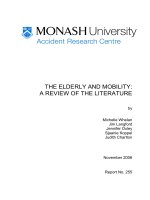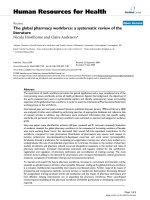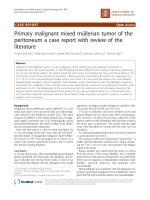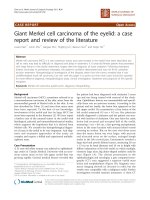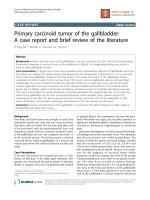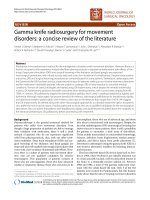Hepatic falciform ligament clear cell myomelanocytic tumor: A case report and a comprehensive review of the literature on perivascular epithelioid cell tumors
Bạn đang xem bản rút gọn của tài liệu. Xem và tải ngay bản đầy đủ của tài liệu tại đây (2.86 MB, 9 trang )
Wang et al. BMC Cancer (2015) 15:1004
DOI 10.1186/s12885-015-1992-4
CASE REPORT
Open Access
Hepatic falciform ligament clear cell
myomelanocytic tumor: A case report and
a comprehensive review of the literature
on perivascular epithelioid cell tumors
Zu-Sen Wang1, Lin Xu1, Lin Ma2, Meng-Qi Song1, Li-Qun Wu1* and Xuan Zhou3
Abstract
Background: The objective of the study was to explore the clinical expression, radiological and pathological
features, differential diagnosis, and biological behavior of a clear cell myomelanocytic tumor. In a case
involving a clear cell myomelanocytic tumor located in the hepatic falciform ligament, we evaluated clinical
expression, radiological characteristics, histopathology, immunohistochemistry, and biological behavior; we also
reviewed the relevant literature.
Case presentation: Clear cell myomelanocytic tumor is a benign soft-tissue neoplasm that often occurs in
women, and is expressed as a painless mass. The falciform ligament is its most frequent site of occurrence.
The imaging characteristics of this lesion were uneven enhancement in the arterial phase, continuing to
strengthen in the venous phase, and equal density in the balance phase. Histological and immunohistochemical
analysis revealed the main transparent epithelioid cells and smooth muscle spindle cells to be HMB-45(+), smooth
muscle actin(+), and melan-A (+).
Conclusion: Hepatic vascular epithelioid cell tumors are very rare mesenchymal neoplasms. Few studies have
investigated this tumor in the hepatic falciform ligament; consequently, its diagnosis and the selection of an
appropriate treatment and follow-up protocol are challenging. Treatment outcome remains unpredictable.
Therefore, clear cell myomelanocytic tumor should be viewed as a tumor with uncertain malignant potential
requiring long-term follow-up.
Keywords: CCMMT, Diagnosis, Immunohistochemistry, PEComa
Background
Perivascular epithelioid cell (PEComa) tumor has recently been cytopathologically defined. Histological and
immunohistochemical analysis indicate that it has the
obvious characteristics of perivascular epithelioid cells
(PECs) [1, 2]. A type of tumor with hyaline cells that has
the characteristics and similarity to a neoplasm with
perivascular epithelioid cell differentiation is determined
as follows according to the World Health Organization
(2002) soft-tissue tumor classification: a neoplasm with
perivascular epithelioid cell differentiation, including
hepatic falciform ligament clear cell myomelanocytic tumors [3]. Because soft-tissue clear cell myomelanocytic
tumor (CCMMT) is a newly identified tumor type, there
have been very few previous studies. This tumor usually
involves the uterus, followed by the sickle ligament and
gut. There have been only two reported cases of
CCMMT in the liver [4]; thus, the diagnosis and differential biological behavior of this neoplasm require further study. The present report involves the evaluation of
a case of CCMMT and a review of the relevant
literature.
* Correspondence:
1
Department of Hepatobiliary Surgery, Affiliated Hospital of Qingdao
University, Qingdao, Shandong 266003, China
Full list of author information is available at the end of the article
© 2015 Wang et al. Open Access This article is distributed under the terms of the Creative Commons Attribution 4.0
International License ( which permits unrestricted use, distribution, and
reproduction in any medium, provided you give appropriate credit to the original author(s) and the source, provide a link to
the Creative Commons license, and indicate if changes were made. The Creative Commons Public Domain Dedication waiver
( applies to the data made available in this article, unless otherwise stated.
Wang et al. BMC Cancer (2015) 15:1004
Case presentation
A 29-year-old woman was admitted to our hospital in
July 2014 with liver cancer rupture after intervention
over a period of 1 month. She had a treatment history
involving L-carnitine drugs proceeded by cesarean section (4 months ago), and no history of hepatitis and
hepatocirrhosis. A physical examination revealed the following: the right side of the abdomen was slightly
bloated; there was a 10-cm surgical scar on the hypogastrium, and a palpable 5 × 6 cm mass was present in the
right upper abdomen; the mass was hard, smooth, and
had good texture; and there was no pain when the mass
was pressed. Laboratory examination revealed routine
hepatic and renal function, and normal levels of serum
electrolytes and alpha fetoprotein.
Ultrasound examination of the digestive system
demonstrated the following: a heterogeneous hyperechoic mass (15.5 × 9.6 × 14.2 cm) located in the right
hepatic lobe; an irregular anechoic area in the mass; a
clear boundary; and no obvious blood flow signal in
the mass examined using color Doppler flow imaging
(Fig. 1). A plain abdominal computed tomography
(CT) scan showed a huge abdominal mass below the
right segment of the anterior hepatic lobe, an uneven
internal density, and high and low mixed density
(Fig. 2). A dynamic enhanced CT scan of the upper
abdomen demonstrated the following: a mixed highand low-density mass shadow in the right anterior
hepatic lobe below segment S5; a clear boundary; a
neat outline; significant uneven enhancement; internally, a large area of low-density non-enhanced
shadow; multiple enlargement of the surrounding vessels; and a low-density coated edge.
Hepatic arterial enhancement was uneven, but the venous and balance periods strengthened more evenly (Fig. 3).
A dynamic enhanced magnetic resonance imaging (MRI)
scan of the upper abdomen revealed the following: a huge
mass in the right anterior hepatic lobe; an uneven internal
density; an obvious uneven strengthening; and a visible liquefied necrotic area within the mass (Fig. 4). A hepatic
adenoma was diagnosed using the imaging data. During
Page 2 of 9
surgery, the following was found: the mass was located in
the V segment of the liver; its diameter was approximately
10 cm; and the mass exhibited cystic and solid characteristics, and had invaded the gallbladder and part of the hepatic segment VI. Consequently, the patient underwent
hepatic V segment excision, partial VI segment excision,
and gallbladder excision. Postoperative recovery was good.
Pathological examination
Macroscopic examination Macroscopic examination
revealed the following: a liver tissue of size 19 × 14 ×
7 cm; the presence of a nodular goiter in the liver after
sectioning with an area of 11 × 9 cm; the goiter was
grayish red and grayish yellow and had a crisp quality;
and there was partial invasion of the local liver capsule.
Microscopic examination Microscopic examination revealed the following: the tumor had a high cell density;
cells were fusiform or ovoid in shape; in parts of the
tumor, the cells were epithelioid; the cytoplasm was
weakly acidophilic or bright; small nucleoli and nuclear
grooves were visible; mitotic figures were rare; there was
a diffuse distribution of tumor cells; the lesion had an
obscure boundary; a hemorrhage was present in part of
the tumor; necrosis was evident; and a multinucleated
giant cell reaction occurred. Liver cell edema associated
with mild cholestasis was observed in the surrounding
hepatic tissues, together with dilated vessels in the central vein and portal area (Fig. 5).
Immunohistochemistry
Immunohistochemical analysis of tumor cells indicated
the following: HMB-45(+); vimentin(+); smooth muscle
actin (SMA)(+); melan-A(+); CK(−); hepatocyte(−); Arg1(−); GPC-3(−); CK7(−); CK19(−); CK20(−); S-100(−);
CD34 blood vessel endothelium(+); and no exact tumor
suppository (Figs. 6 and 7). The pathological diagnosis
was a hepatic falciform ligament clear cell myomelanocytic tumor.
Fig. 1 Ultrasound scan of the digestive system. A heterogeneous high echogenic mass can be seen in the right liver lobe. An irregular anechoic
area is also evident in the mass; color Doppler flow imaging showed no obvious blood signal in it
Wang et al. BMC Cancer (2015) 15:1004
Page 3 of 9
Fig. 2 Upper abdominal computed tomography scan. A giant tumor can be seen in the right anterior superior segment of the liver. Its internal
density is uneven and exhibits a high/low/equal mix
Discussion
PEComa is a tumor family that includes the following:
angiomyolipoma (AML), a clear cell “sugar” tumor of
the lung (CCST); lymphangioleio-myomatosis (LAM),
CCMMT with rare occurrence in the pancreas; and lucency cell tumors in the rectum, peritoneum, uterus,
and other organs. The other tumors occur in many parts
of the body, including the chest, gastrointestinal tract,
sinus, bone trunk, and liver; most have been described
exclusively in case reports [5–8]. In 1992, Bonetti et al.
[9] first proposed the name lung hyaline cell “sugar”
tumor for angioleiomyolipoma and lymphangioleiomyomatosis cells with the same morphology and immune
phenotype as PECs. In 1996, Zamboni et al. [10] reported a case of lung hyaline cell “sugar” tumor, which
was very similar to pancreas hyaline cell tumor; consequently, we suggested the term PEComa for PEC tumors
located in different places and with no connection.
Armah et al. [11] proposed that PEComa tumors, with
the exception of AML, LAM, and CCST, should be
named PEComa-NOS (not otherwise specified) tumors,
or should be known by some other name such as
CCMMT or primary extrapulmonary sugar tumor; they
used monotype epithelioid AML as a synonym of
PEComa. The name PEC sarcoma has been changed to
PEComa. CCMMT is one of the tumors originating
from blood vessels surrounding epithelioid cells. In our
case, the CCMMT in the falciform ligament belonged to
the PEComa family.
Clinical characteristics
Jafari et al. [12] reported the following: hepatic PEComa
occurred more often in women; the peak incidence was
in patients aged 40–70 years; it occurred more frequently in the liver; many of the tumors were solitaryand
easily misdiagnosed as hepatocellular carcinoma; and a
few tumors exhibited malignant behavior. The onset of
the disease manifests insidiously, and most patients have
no history of liver diseases. The symptoms and signs of
the disease reveal no specificity; furthermore, they are
similar to other tumors arising from the liver. Generally,
indigestion, loss of appetite, nausea, and intermittent
colic pain can occur. On physical examination, tenderness to palpation and liver enlargement may be observed; in some patients, these tumors have been
detected by means of imaging examination during a
health check-up. The tumor markers AFP, CEA, and
CA19-9 were all negative. Most patients were diagnosed
after a postoperative pathological examination [13, 14].
Priola et al. [15] reported a case of acute abdominal disease caused by PEComa.
Fig. 3 Upper abdominal dynamic enhancement computed tomography scan. Hepatic arterial enhancement is uneven, but the strengthening of
the venous and balance periods is more even
Wang et al. BMC Cancer (2015) 15:1004
Page 4 of 9
Fig. 4 Magnetic resonance imaging scan of the upper abdomen. The mass exhibits uneven strengthening and the internal liquefied necrotic
area has no strength
Imaging manifestations
Imaging manifestations of hepatic PEComa have rarely
been mentioned in previous studies. Hepatic PEComa
exhibits a variety of imaging findings. Ameurtesse et al.
[16] found that hepatic PEComa could be expressed as a
range of echo types under ultrasound examination, and,
in most of the conditions, the lesions or tissue surrounding the lesions expressed a rich blood supply. Generally
in the CT or MRI scans, the lesions in the arterial phase
strengthen more obviously, continue to strengthen in
the venous phase; delayed scanning usually reveals equidensity [17–19].
Most of the lesions show low signal intensity in T1weighted imaging, and high signal intensity in T2weighted imaging; a rich tumor blood supply is usually
associated with liver cancer and liver hemangioma [20].
Preoperative imaging studies (CT and MRI) have poor
diagnostic sensitivity regarding PEComa; the reported
preoperative diagnostic accuracy of CT and MRI is
15.7 % (11/70) and 22.7 % (10/44), respectively [21]. Imaging findings regarding our case were basically the
same as those previously reported. The lesion had a
liquefied necrotic area, strengthening of the liver parenchyma in the arterial phase was uneven, and strengthening in the intravenous and balance periods were even.
The preoperative diagnosis was hepatic adenoma, and
postoperative pathology revealed CCMMT located in
the hepatic falciform ligament. There have been numerous reports regarding AML imaging, but reports concerning the imaging features of CCST, LAM, and
CCMMTs are rare; preoperative imaging diagnosis is difficult and mainly relies on postoperative pathologic
examination.
Pathological features and immunohistochemistry
Pathological characteristics
PEComa tumor cells always surround blood vessels and
are arranged in a radiated or sleeve pattern. Usually, the
adjacent blood vessel cells are epithelioid in shape; cells
that are located far from the blood vessels have a fusiform shape and the appearance of smooth muscle cells.
The cytoplasm of the tumor cells is clear and eosinophilic [22], the nucleus is usually small and round or
oval in shape, has a small nucleolus, contains fine chromatin, is located in the meso-position, and nuclear division is rarely seen. However, in a few cases it is possible
to observe obvious hyperchromatic irregular-shaped nuclei, an increase in the size of the nucleolus, an increase
in the number of mitotic figures, the presence of melanophores, focal necrosis, and an intravascular tumor
embolus; these findings indicate a poor prognosis [23–
25]. PEComa-NOS and PEComa occurring in different
regions of the body are similar. The lesion can be
formed by epithelioid PECs and is referred to as CCST
like; it can also be formed by fusiform PECs, and usually
appears similar to the funicular line that is referred to as
CCMMT like.
Immunohistochemistry
Fig. 5 Microscopic examination. Tissue sections after hematoxylineosin staining were observed at 400× magnification
PEComa tumors have similar immunohistochemical
characteristics, mainly including melanin cell markers
(HMB-45 and/or melan A) and smooth muscle cell
Wang et al. BMC Cancer (2015) 15:1004
Page 5 of 9
Fig. 6 Immunohistochemistry 1. Immunohistochemical analysis of tumor cells indicated the following: HMB-45(+), vimentin(+), smooth muscle
actin (SMA)(+), melan-A(+,CK(−), and hepatocyte(−)
markers (microfilament protein and/or desmin) [22].
In 1991, two studies reported that hepatic and kidney
PEComa tumors were all positive for HMB-45 [26,
27]. These findings were confirmed in the present
study. Melanocytes and smooth muscle cell markers
play a significant role in the diagnosis of this type of
tumor [28, 29]. In previous studies, it was believed
that PEComa tumors simultaneously expressed melanocyte and smooth muscle cell markers. However, a
study by Folpe et al. demonstrated that only 80 % of
cases simultaneously expressed these two types of
markers [6]. Thus, negativity for smooth muscle cell
markers did not rule out the diagnosis of having this
disease [30]. Ameurtesse et al. [16] concluded that
the immunohistochemical characteristics of hepatic
PEComas included: generally positive expression of
HMB-45; frequently positive expression of melan-A
and SMA; and negative expression of S100, desmin,
and vimentine. With the exception of the immunohistochemical markers detailed above, the expression of
other markers including CD34 and CD117 differed
between PEComas [18, 31, 32].
Differential diagnosis
The differential diagnosis of CCMMT relies predominantly on cell morphology and immunohistochemistry [33].
Soft-tissue clear cell sarcoma
Both soft-tissue clear cell sarcoma and CCMMT occur
more frequently in dense connective tissue, have
Fig. 7 Immunohistochemistry 2. Immunohistochemical analysis of tumor cells indicated the following: Arg-1(−), GPC-3(−), CK7(−), CK19(−), CK20(−),
and S-100 (−)
Wang et al. BMC Cancer (2015) 15:1004
common clear cells and nucleoli, visible melanin particles, and the tumor cells express HMB-45; thus, they are
easily confused. However, soft-tissue clear cell sarcoma
always occurs in limb tendons and the tendon membrane area. It has the following characteristics: the cells
are fusiform; it typically has a nest-like distribution; the
nucleolus is bigger and more obvious than those in
CCMMT cells; it shows strong basophilia; and it has a
lack of characteristic vascular components [34]. Immunohistochemistry may be valuable in distinguishing between these two tumor types. CCMMT co-expresses
melanocytic markers and smooth muscle markers but
lack S-100 protein expression, whereas clear cell
sarcoma in the tendons and aponeuroses express both
S-100 protein and the melanocytic markers, but do not
express smooth muscle actin or myosin [35, 36].
Malignant clear cell mesothelioma
All malignant clear cell mesotheliomas occur in the abdominal cavity and have clear cells. However, malignant
clear cell mesothelioma exhibits the following characteristics: malignant progression, always with ascites; a
tendency to grow in the peritoneum; a nodular-like appearance; the presence of clear cells that are partially
gland like; the edematous degeneration of papilloma epithelial cells; lipid accumulation in foam sample cells can
occur; and immunohistochemically it is positive for CK
and Vim. Its positivity for the mesothelial cell-related
antibody allows it to be distinguished from CCMMT
cells [33, 37].
Clear cell leiomyoma
Clear cell leiomyoma cells are similar to CCMMT clear
cells and smooth muscle spindle cells, and have comparable positive expression of SMA; however, CCMMT cells
have a lighter nucleus, its entire cytoplasm appears clear,
vacuoles in some cells compress the nucleus and show a
signet ring shape, and the epithelioid cells all exhibit a
funicular distribution. Clear cell leiomyoma cells do not
express HMB-45, and can therefore also be distinguished
from CCMMT cells [38].
Dedifferentiated liposarcoma
The key factor in the diagnosis of dedifferentiated liposarcoma is to determine if the tumor contains true lipoblasts; liposarcoma can also express S100 protein, but
not HMB-45 [39].
Leiomyosarcoma
Leiomyosarcoma differs from CCMMT in that it displays shorter fascicles that intersect at right angles to
one another, more pronounced cytoplasmic eosinophilia,and elongated nuclei with blunt ends [33]. The nested
growth pattern, the vesicular nuclei with small
Page 6 of 9
prominent nucleoli, and the rather uniform clear cell
change that characterize CCMMT would not usually be
expected to be encountered in leiomyosarcoma. In
addition, leiomyosarcoma usually does not express antibodies to melanosomal proteins, such as S-100 or
melan-A [40, 41]. Additionally, the majority of leiomyosarcomas express desmin [42], in contrast to CCMMTs,
which are desmin negative.
Monotypic angiomyolipoma
Recently, monotypic angiomyolipomas which differ from
the usual angiomyolipoma have been described. They consist entirely or nearly entirely of perivascular epithelioid
cells with only rare thick-walled blood vessels or areas of
“adipocytic differentiation”. These tumors differ significantly from CCMMTs because they are composed of epithelioid cells and exhibit a lack of the spindled cells with
cytoplasmic clearing and the characteristic nested growth
pattern of CCMMT [43, 44]. CCMMT should also not be
confused with malignant angiomyolipoma. These tumors
differ from CCMMTs in that they show sarcomatous differentiation with marked nuclear pleomorphism, elevated
mitotic activity, and necrosis [1, 46].
Other common differential diagnoses include: epithelioid sarcoma; hepatic adenoma and carcinoma; gastrointestinal stromal tumors; metastatic sarcomatoid renal
cell carcinoma; paraganglioma; and oncocytic and clear
cell carcinoma. The positivity for melanocytic markers
and the negativity for multiple markers including CK,
CD34, S-100, and EMA confirm the diagnosis (Table 1)
[22, 14, 16].
Biological behavior
Blood vessels surrounding the epithelioid cells in the
tumor are characteristic of benign and malignant undefined tumors. Most patients with PEComas demonstrate benign biological behavior and unfavorable
prognosis, while a few have malignant behavior and an
unfavorable prognosis [6, 46]. At present, there are no
clear diagnostic criteria for malignant PEComa; the
clinical biological behavior of the tumor has always been
controversial. According to the World Health
Organization 2003 guidelines, a PEComa tumor should
be viewed as malignant if it exhibits the following features: infiltrating growth; a high cell density, nuclear enlargement and hyperchromatism; an increased number
of mitotic figures; and atypical nuclear division and coagulative necrosis are present. In 2005, Flope et al. [6]
studied 26 cases of PEComa that occurred in the soft tissue and gynecologic reproductive organs; they proposed
a series of standards whereby it could be subdivided into
tumors having benign characteristics, uncertain malignant potential, or malignant potential.
Wang et al. BMC Cancer (2015) 15:1004
Page 7 of 9
Table 1 Immunohistochemistry in the differential diagnosis of CCMMT
CCMMT
Hepatic carcinoma
Melanoma
Gastrointestinal stromal tumors
SMA
positive
HMB-45
positive
positive
Melan-A
positive
positive
S-100
negative
positive
variable
CK
negative
positive
negative
negative
EMA
negative
positive
negative
CD34
positive
Paraganglioma
variable
Diagnostic criteria for malignant PEComa should include two or more of the following: tumor size >5 cm;
infiltrative growth; a high nuclear and cell density; a mitotic ratio ≥1/50 high power; and signs of coagulative
necrosis and vascular invasion. PEComa of uncertain
malignant potential only exhibits polymorphism/multicore giant cells, or only has a size >5 cm, but no other
histological abnormalities. Benign PEComa tumors are
<5 cm in size and have no other histologic abnormalities. These criteria have gradually been applied in
PEComa diagnosis, but still have limitations, and there
are special cases were they are not applicable; for example, in long-term lymphangioleiomyomatosis involving a wide range, the influence of pulmonary interstitial
fibrosis caused by the disease is similar to the effects of
a tumor. The recurrence and metastasis of epithelioid
PEComa is apparently higher than is the case in normal
PEComa. Thus, an accurate assessment of the biological
behavior of PEComa and prognosis data accumulated
from more cases and clinical long-term follow-up studies will be required.
Treatment and prognosis
Currently, excision is the only method that has been
used to treat this disease, and can achieve a radical
cure in most cases. Although most PEComa tumors
exhibit benign behavior, there have been reports of
local invasion and remote metastasis [47, 48]. In
addition, there have been a few reports of remote metastasis in post-excision cases [48–50]. However, no
other effective method is currently available for the
treatment of malignant PEComa, especially postoperation. In a study by Martignoni et al. [1], it was
shown that activated mTORC1 to TSC, related or not
related to PEComa, had an important function; an
mTORC1 inhibitor such as rapamycin may have a
therapeutic effect regarding PEComa. In an animal
TSC model study that preceded the preclinical phase
study, a significant curative effect was demonstrated;
the same treatment protocol was also effective in kidney AML. Wagner et al. [51] evaluated oral administration of the mTOR inhibitor sirolimus in the
positive
positive
treatment of three cases of malignant PEComa; the
imaging data revealed that the tumor responded to
treatment, indicating that it could potentially be used
as a targeted therapy for PEComa. Italiano et al. [52]
reported cases where the mTOR inhibitor temsirolimus had the same effect; however, more clinical trials
are required to confirm this finding. Long-term close
follow-up of patients with PEComa is necessary, and
PET-CT can be used as part of the follow-up examination protocol [53, 54].
Conclusions
An epithelioid cell tumor surrounded by hepatic blood
vessels is a very rare gastrointestinal mesenchymal
tumor; a hepatic falciform ligament CCMMT belongs to
this group. Relevant studies regarding the methods used
for its diagnosis are rare.
Treatment methods and questions concerning the design of the follow-up protocol remain a challenge, and
prognosis continues to be unpredictable. All of these lesions should be diagnosed as tumors with uncertain malignant potential, which require stricter long-term
follow-up evaluation.
Ethics Statement
The study was approved by the Ethic Committee of the
Affiliated Hospital of Qingdao University Medical College. The IRB number is QYFYEC KY2015-002-010. The
patient provided written informed consent.
Consent
Written informed consent was obtained from the patient for publication of this Case report and any accompanying images. A copy of the written consent is
available for review by the Editor of this journal.
Abbreviations
PEComa: Perivascular epithelioid cell tumor; PECs: Perivascular epithelioid
cells; CCMMT: Clear cell myomelanocytic tumor; CT: Computed tomography;
MRI: Magnetic resonance imaging; HMB-45: Human melanoma black 45;
SMA: Smooth muscle actin; melan-A: Protein melan-A; CKs: Cytokeratins;
EMA: Epithelial membrane antigen; Arg-1: Arginase 1; GPC-3: Glypican 3;
CD34: Cluster of differentiation antigen 34.
Wang et al. BMC Cancer (2015) 15:1004
Competing interests
The authors declare that they have no competing interests.
Authors’ contributions
ZSW, LX, LM, MQS, and LQW participated in the surgery, data interpretation,
and manuscript preparation. XZ performed the immunohistochemistry. ZSW
and LX wrote and edited the manuscript. All authors read and approved the
final manuscript.
Acknowledgments
We thank the Department of Pathology at Qingdao Municipal Hospitals who
provided technical support regarding the tissue microarray.
Author details
1
Department of Hepatobiliary Surgery, Affiliated Hospital of Qingdao
University, Qingdao, Shandong 266003, China. 2Department of General
Surgery, Qingdao Eighth People’s Hospital, Qingdao, Shandong 266003,
China. 3Department of Pathology, Affiliated Hospital of Qingdao University,
Qingdao, Shandong 266003, China.
Received: 2 July 2015 Accepted: 11 December 2015
References
1. Martignoni G, Pea M, Reghellin D, Zamboni G, Bonetti F. PEComas: the past,
the present and the future. Virchows Arch. 2008;452(2):119–32.
2. Hornick JL, Fletcher CDM. PEComa: what do we know so far?
Histopathology. 2006;48(1):75–82.
3. Fletcher CD, Unni KK, Mertens F, Krisjnan X, Mertens X, Fredrik X. World
Health Organization Classification of Tumors of Pathology and genetics of
soft tissue and bone. Lyon: IARC Press; 2002. p. 221–2.
4. Tan Y, Zhang H, Xiao EH. Perivascular epithelioid cell tumour: dynamic CT,
MRI and clinicopathological characteristics—analysis of 32 cases and review
of the literature. Clin Radiol. 2013;68(6):555–61.
5. Fukunaga M. Perivascular epithelioid cell tumor (PEComa) of soft tissue: case
report with ultrastructural study. Apmis. 2004;112(2):98–104.
6. Folpe AL, Mentzel T, Lehr HA, Fisher C, Balzer BL, Weiss SW. Perivascular
epithelioid cell neoplasms of soft tissue and gynecologic origin: a
clinicopathologic study of 26 cases and review of the literature. Am J Surg
Pathol. 2005;29(12):1558–75.
7. Kazzaz D, Khalifa M, Alorjan M, Shaw M, Rezajooi K, Saifuddin A. Malignant
PEComa of the lumbar vertebra: a rare bone tumour. Skelet Radiol. 2012;
41(11):1465–8.
8. Lau SK. Malignant PEComa of the adrenal gland. Pathol Res Pract. 2012;
208(2):113–7.
9. Bonetti F, Pea M, Martignoni G, Zamboni G. PEC and sugar. Am J Surg
Pathol. 1992;16(3):307–8.
10. Zamboni G, Pea M, Martignoni G, Zancanaro C, Faccioli G, Gilioli E. Clear cell
“sugar” tumor of the pancreas: a novel member of the family of lesions
characterized by the presence of perivascular epithelioid cells. Am J Surg
Pathol. 1996;20(6):722–30.
11. Armah HB, Parwani AV. Perivascular epithelioid cell tumor. Arch Pathol Lab
Med. 2009;133(4):648–54.
12. Jafari A, Fischer HP, von Websky M, Hong GS, Kalff JC, Manekeller S.
Primary Perivascular Epitheloid Cell Tumour (PEComa) of the Liver: Case
Report and Review of the Literature. Z Gastroenterol. 2013;51(9):
1096–100.
13. Chang Z, Zhang JM, Ying JQ, Ge YP. Characteristics and treatment strategy
of hepatic angiomyolipoma: a series of 94 patients collected from four
institutions. J Gastrointestin Liver Dis. 2011;20(1):65–9.
14. Strzelczyk JM, Durczynski A, Szymanski D, Jablkowski M, Dworniak D, Sporny
S. Primary perivascular epithelioid cell tumor (PEComa) of the liver: report of
a case. Surg Today. 2009;39(10):916–21.
15. Priola AM, Priola SM, Cataldi A, Marci V, Fava C. Acute abdomen as an
unusual presentation of hepatic PEComa. A case report. Tumori. 2009;
95(1):123–8.
16. Ameurtesse H, Chbani L, Bennani A, Toughrai I, Beggui N, Kamaoui I, et al.
Primary perivascular epithelioid cell tumor of the liver: new case report and
literature review. Diagn Pathol. 2014;9(1):149.
Page 8 of 9
17. Högemann D, Flemming P, Kreipe H, Galanski M. Correlation of MRI and CT
findings with histopathology in hepatic angiomyolipoma. Eur Radiol. 2001;
11(8):1389–95.
18. Yamamoto H, Oda Y, Yao T, Oiwa T, Kobayashi C, Tamiya S, et al. Malignant
perivascular epithelioid cell tumor of the colon: report of a case with
molecular analysis. Pathol Int. 2006;56(1):46–50.
19. Fang SH, Zhou LN, Jin M, Hu JB. Perivascular epithelioid cell tumor of the
liver: a report of two cases and review of the literature. World J
Gastroenterol. 2007;13(41):5537–9.
20. Sheng HQ, Chen DF, Sun XH, Li X, Xu J, Hu XB, et al. MRI diagnosis of
perivascular epithelioid cell tumor (PEComa) of the liver. Rom J Morphol
Embryol. 2013;54(3):643–7.
21. Baez JC, Landry JM, Saltzman JR, Qian X, Zinner MJ, Mortelé KJ.
Pancreatic PEComa (sugar tumor): MDCT and EUS features. JOP. 2009;
10(6):679–82.
22. Folpe AL, Kwiatkowski DJ. Perivascular epithelioid cell neoplasms: pathology
and pathogenesis. Hum Pathol. 2010;41(1):1–15.
23. Baek JH, Chung MG, Jung DH, Oh JH. Perivascular epithelioid cell tumor
(PEComa) in the transverse colon of an adolescent: a case report. Tumori.
2007;93(1):106–8.
24. Wen MC, Jan YJ, Li MC, Wang J, Lin A. Monotypic epithelioid
angiomyolipoma of the liver with TFE3 expression. Pathology. 2010;42(3):
300–2.
25. Ahn JH, Hur B. Primary Perivascular Epithelioid Cell Tumor (PEComa) of the
Liver-A case report and review of the literature. Korean J Pathol. 2011;45
Suppl 1:S93–7.
26. Pea M, Bonetti F, Zamboni G, Martignoni G, Riva M, Colombari R, et al.
Melanocyte-marker-HMB-45 is regularly expressed in angiomyolipoma of
the kidney. Pathology. 1991;23(3):185–8.
27. Weeks DA, Malott RL, Arnesen M, Zuppan C, Aitken D, Mierau G. Hepatic
angiomyolipoma with striated granules and positivity with melanomaspecific antibody (HMB-45): a report of two cases. Ultrastruct Pathol. 1991;
15(4–5):563–71.
28. Pea M, Martignoni G, Zamboni G, Bonetti F. Perivascular epithelioid cell. Am
J Surg Pathol. 1996;20(9):1149–53.
29. Ashfaq R, Weinberg AG, Albores‐Saavedra J. Renal angiomyolipomas and
HMB‐45 reactivity. Cancer. 1993;71(10):3091–7.
30. Sundram U, Harvell JD, Rouse RV, Natkunam Y. Expression of the B-cell
proliferation marker MUM1 by melanocytic lesions and comparison with
S100, gp100 (HMB45), and MelanA. Mod Pathol. 2003;16(8):802–10.
31. Nonomura A, Enomoto Y, Takeda M, Tamura T, Kasai T, Yosikawa T, et al.
Invasive growth of hepatic angiomyolipoma; a hitherto unreported
ominous histological feature. Histopathology. 2006;48(7):831–5.
32. Li T, Wang L, Yu HH, Sun HC, Qin LX, Ye QH, et al. Hepatic angiomyolipoma:
a retrospective study of 25 cases. Surg Today. 2008;38(6):529–35.
33. Zhang XG, Wang L, Jiang Y, Wan Z, Li W, Yao C. Hepatic perivascular
epithelioid cell tumors-not otherwise specified: a case report. J South Med
Univ. 2014;34(1):1–4.
34. Malchau SS, Hayden J, Hornicek F, Mankin HJ. Clear cell sarcoma of soft
tissues. J Surg Oncol. 2007;95(6):519–22.
35. Swanson PE, Wick MR. Clear cell sarcoma. An immunohistochemical analysis
of six cases and comparison with other epithelioid neoplasms of soft tissue.
Arch Pathol Lab Med. 1989;113(1):55–60.
36. Rubin BP, Fletcher JA, Renshaw AA. Clear cell sarcoma of soft parts: report
of a case primary in the kidney with cytogenetic confirmation. Am J Surg
Pathol. 1999;23(5):589–94.
37. Dessy E, Falleni M, Braidotti P, Del Curto B, Panigalli T, Pietra GG. Unusual
clear cell variant of epithelioid mesothelioma. Arch Pathol Lab Med. 2001;
125(12):1588–90.
38. Vang R, Kempson RL. Perivascular epithelioid cell tumor (PEComa') of the
uterus: a subset of HMB-45-positive epithelioid mesenchymal neoplasms
with an uncertain relationship to pure smooth muscle tumors. Am J Surg
Pathol. 2002;26(1):1–13.
39. Guillou L. Pleomorphic sarcomas: subclassification, myogenic differentiation
and prognosis. Diagn Histopathol. 2008;14(11):527–37.
40. Bonetti F, Pea M, Martignoni G, Mombello A, Colombari R, Zamboni G, et al.
False-positive immunostaining of normal epithelia and carcinomas with
ascites fluid preparations of antimelanoma monoclonal antibody HMB45.
Am J Clin Pathol. 1991;95(4):454–9.
41. Kaufmann O, Koch S, Burghardt J, Audring H, Audring H, Dietel M.
Tyrosinase, melan-A, and KBA62 as markers for the immunohistochemical
Wang et al. BMC Cancer (2015) 15:1004
42.
43.
44.
45.
46.
47.
48.
49.
50.
51.
52.
53.
54.
Page 9 of 9
identification of metastatic amelanotic melanomas on paraffin sections.
Mod Pathol. 1998;11(8):740–6.
Truong LD, Rangdaeng S, Cagle P, Ro JY, Hawkins H, Font RL. The
diagnostic utility of desmin. A study of 584 cases and review of the
literature. Am J Clin Pathol. 1990;93(3):305–14.
Eble JN, Amin MB, Young RH. Epithelioid angiomyolipoma of the kidney: a
report of five cases with a prominent and diagnostically confusing epithelioid
smooth muscle component. Am J Surg Pathol. 1997;21(10):1123–30.
Martignoni G, Pea M, Bonetti F, Zamboni G, Carbonara C, Longa L, et al.
Carcinomalike monotypic epithelioid angiomyolipoma in patients without
evidence of tuberous sclerosis: a clinicopathologic and genetic study. Am J
Surg Pathol. 1998;22(6):663–72.
Al-Saleem T, Wessner LL, Scheithauer BW, Patterson K, Roach ES, Dreyer SJ, et al.
Malignant tumors of the kidney, brain, and soft tissues in children and young
adults with the tuberous sclerosis complex. Cancer. 1998;83(10):2208–16.
Selvaggi F, Risio D, Claudi R, Cianci R, Angelucci D, Pulcini D, et al.
Malignant PEComa: a case report with emphasis on clinical and
morphological criteria. BMC Surg. 2011;11(1):3.
Vos D, Damme V. Malignant angiomyolipoma of the liver: a hitherto
unreported variant. Histopathology. 2000;36(5):443–50.
Parfitt JR, Bella AJ, Izawa JI, Wehrli BM. Malignant neoplasm of perivascular
epithelioid cells of the liver. Arch Pathol Lab Med. 2006;130(8):1219–22.
Lai HY, Chen CK, Lee YH, Tsai PP, Chen JH, Shen WC. Multicentric
aggressive angiomyolipomas: a rare form of PEComas. Am J
Roentgenol. 2006;186(3):837–40.
Dimmler A, Seitz G, Hohenberger W, Kirchner T, Faller G. Late pulmonary
metastasis in uterine PEComa. J Clin Pathol. 2003;56(8):627–8.
Wagner AJ, Malinowska-Kolodziej I, Morgan JA, Qin W, Fletcher CD, Vena N,
et al. Clinical activity of mTOR inhibition with sirolimus in malignant
perivascular epithelioid cell tumors: targeting the pathogenic activation of
mTORC1 in tumors. J Clin Oncol. 2010;28(5):835–40.
Italiano A, Delcambre C, Hostein I, Cazeau AL, Marty M, Avril A, et al.
Treatment with the mTOR inhibitor temsirolimus in patients with malignant
PEComa. Ann Oncol. 2010;21(5):1135–7.
Arnold RT, Myers DT. Visualization of renal angiomyolipoma on F-18 FDG
PET/CT. Clin Nucl Med. 2009;34(8):539–40.
Zarbis N, Barth TFE, Blumstein NM, Schelzig H. Pecoma of the lung: a
benign tumor with extensive 18 F-2-deoxy-D-glucose uptake. Interact
Cardiovasc Thorac Surg. 2007;6(5):676–8.
Submit your next manuscript to BioMed Central
and we will help you at every step:
• We accept pre-submission inquiries
• Our selector tool helps you to find the most relevant journal
• We provide round the clock customer support
• Convenient online submission
• Thorough peer review
• Inclusion in PubMed and all major indexing services
• Maximum visibility for your research
Submit your manuscript at
www.biomedcentral.com/submit
